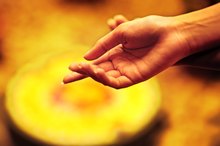The skin of your palms and fingers serves as your primary interface with your environment and other people. This high level of exposure makes your palms vulnerable to a host of short- and long-term problems that can manifest as one or more bumps. Infections and various skin disorders are common culprits.
Warts
Warts develop due to infection of superficial skin cells with the human papillomavirus. As the viruses reproduce in the skin cells, one or more bumps form that are usually painless but might itch. Warts can grow virtually anywhere on the body but are particularly common on the hands and feet. Palmar warts, also known as verruca palmaris, often occur in groups and may affect one or both hands. Over-the-counter treatments often eliminate these warts 3. Medical therapy, such as freezing the warts with liquid nitrogen, is often faster and more effective -- especially if you have several warts.
- Warts develop due to infection of superficial skin cells with the human papillomavirus.
- Medical therapy, such as freezing the warts with liquid nitrogen, is often faster and more effective -- especially if you have several warts.
Pompholyx
What Causes Skin to Peel on the Hands?
Learn More
Pompholyx is a 10-dollar medical word that describes a relatively common condition. The name derives from the Greek word for bubble, an apt moniker for a condition that causes small, itchy blisters on the palms and fingers. The blisters are usually preceded by several hours of itchiness or burning. Pompholyx usually affects both hands. Some people also develop blisters on the soles of their feet. Other names for pompholox include dyshidrotic eczema and vesicular hand dermatitis. The condition affects people of all ages but occurs most frequently in young to middle-aged adults. The cause is unknown. The blisters typically go away in 3 to 4 weeks but the condition often recurs. Cold compresses and topical steroids help control itchiness.
- Pompholyx is a 10-dollar medical word that describes a relatively common condition.
- The blisters typically go away in 3 to 4 weeks but the condition often recurs.
Keratolysis Exfoliativa
Keratolysis exfoliativa is another relatively common condition with a tongue-twister name 5. It appears much like pompholyx with blisters on the palms and fingers but typically without itchiness. The soles are sometimes also involved. After the blisters rupture, the skin peels. The cause of keratolysis exfoliativa is unknown but frequent immersion of the hands in water or exposure to soaps, detergents or other irritants appears to aggravate the condition. The condition typically resolves on its own within 7 to 10 days but might recur. Protecting the hands from irritants and use of hand moisturizers can be helpful but topical steroids are not recommended.
- Keratolysis exfoliativa is another relatively common condition with a tongue-twister name 5.
- The cause of keratolysis exfoliativa is unknown but frequent immersion of the hands in water or exposure to soaps, detergents or other irritants appears to aggravate the condition.
Hand-Foot-and-Mouth Disease
Symptom of Peeling Skin on Hands
Learn More
Hand-foot-and-mouth disease is a contagious viral illness that occurs primarily in children but also affects adults, especially parents and others who work with or care for younsters. As the name implies, the infection causes mildly painful, blister-like bumps inside the mouth and on the palms and soles. A sore throat and fever usually precede the rash by 1 to 2 days. The illness typically clears on its own within 2 weeks.
- Hand-foot-and-mouth disease is a contagious viral illness that occurs primarily in children but also affects adults, especially parents and others who work with or care for younsters.
- As the name implies, the infection causes mildly painful, blister-like bumps inside the mouth and on the palms and soles.
Localized Pustular Psoriasis
Localized pustular psoriasis (LPP) is an unusual form of psoriasis that primarily affects the palms and soles. Crops of pimple-like bumps appear, rupture and dry, leaving the areas with bumps in various stages of healing. LPP most often occurs in young to middle-aged adults and disproportionately affects women. The condition tends to be ongoing but can usually be controlled with medication.
- Localized pustular psoriasis (LPP) is an unusual form of psoriasis that primarily affects the palms and soles.
Tissue Growths
A solitary bump on one palm points toward the possibility of a tissue growth. Many types of noncancerous and cancerous growths are possible. A few examples include:
- Ganglion cyst: a noncancerous, fluid-filled growth that can develop at the base of the fingers on the palm
- Lipoma: a noncancerous fatty growth that usually develops around the base of the thumb
- Palmar fibromatosis, also known as Dupuytren nodule: noncancerous growth of tissue covering finger tendons of the palm, which can lead to inability to straighten one or more fingers
- Cancerous hand tumor: rare tumors that can arise from various tissues, including bone, cartilage, fat or nerve tissue
Leading causes of palmar bumps have been discussed but there are other less common conditions that can also lead to this symptom. See your doctor if you develop one or more bumps on your palms. Optimal treatment depends on an accurate diagnosis 2. Contact your doctor right away if you experience moderate to severe pain, fever or chills, or if the bumps spread or increase in size.
Reviewed and revised by: Tina M. St. John, M.D.
- Leading causes of palmar bumps have been discussed but there are other less common conditions that can also lead to this symptom.
- Contact your doctor right away if you experience moderate to severe pain, fever or chills, or if the bumps spread or increase in size.
Related Articles
References
- Clinical Growths: Abnormal Growths on the Hand and Wrist
- Postgraduate Medical Journal: Diagnosis and Treatment of Swellings in the Hand
- Cochrane Database of Systematic Reviews: Topical Treatments for Skin Warts
- Patient Professional Reference: Pompholyx
- DermNet New Zealand: Exfoliative Keratolysis
- Ferri's Clinical Advisor 2014; Fred F. Ferri
- An Atlas of Psoriasis, 2nd Edition; Lionel Fry
- Plastic and Reconstructive Surgery: Approaches and Techniques; Ross Farhadieh, Neil Bulstrode and Sabrina Cugno
- Indian Journal of Plastic Surgery: Malignant Tumours of the Hand and Wrist
Writer Bio
Dr. Tina M. St. John owns and operates a health communications and consulting firm. She is also an accomplished medical writer and editor, and was formerly a senior medical officer with the U.S. Centers for Disease Control and Prevention. St. John holds an M.D. from Emory University School of Medicine.







